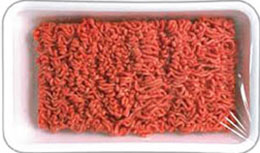The principal spoilage mechanisms that limit the shelf life of cooked, cured and processed meat products are microbial growth, colour change and oxidative rancidity. For cooked meat products, the heating process should kill vegetative bacterial cells, inactivate degradative enzymes and fix the colour. Consequently, spoilage of cooked meat products is primarily due to post-process contamination by microorganisms, as a result of poor hygiene and handling practices. The colour of cooked meats is susceptible to oxidation, and it is important to have only low levels of residual O2 in packs. MAP using CO2/N2 mixes (gas compositions of 25–50% CO2 and 50–75% N2) along with a gas/ product ratio of 2:1 is widely used to maximize the shelf life and inhibit the development of oxidative off-flavours and rancidity. Raw cured meat products, e.g. bacon, owe their characteristic pink reddish colour to nitrosylmyoglobin. This pigment is more stable than oxymyoglobin and is unaffected by high levels of CO2 but is slowly converted to brown met myoglobin in air. During cooking, nitrosylmyoglobin is converted to pink denatured nitrosohemo- chrome pigments that are unstable in air.
Processed meat products such as sausages, frankfurters and beef burgers generally contain sodium metabisulphite, which is an effective preservative against a wide range of spoilage microorganisms and pathogens. Cooked, cured and processed meat products containing high levels of unsaturated fat are liable to be spoiled by oxidative rancidity, but MAP with CO2/N2 mixtures is effective at inhibiting this undesirable reaction.
Potential food poisoning hazards are primarily due to microbial contamination or growth resulting from post-cooking, curing or processing contamination.
These can be minimised by using recommended chilled temperatures, good hygiene and handling practices. The low water activity (aw) and addition of nitrite in cooked, cured and processed meat products inhibit the growth of many food poisoning bacteria, particularly C. botulinum. This inhibition may be compromised in products formulated with lower concentrations of chemical preservatives than those used in traditional foods. The potential effects of any changes in product formulation on the growth and survival of pathogens should always be considered. Cooked meats stored without any added preservatives will be at risk from growth of C. botulinum under anaerobic MAP conditions, particularly when held at elevated storage temperatures. It should be noted that many sliced, cooked, cured and processed meat products are vacuum packed for retail sale. However, the shelf life of such products in MAP is similar to that achieved in vacuum packs, and additionally, MAP allows for easier separation of meat slices.
[SECTION B MAIN FOOD TYPES, Michael Mullan and Derek McDowell]



